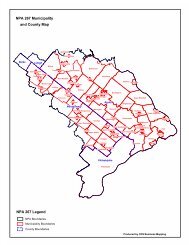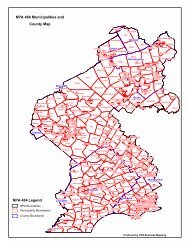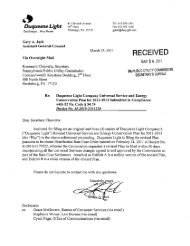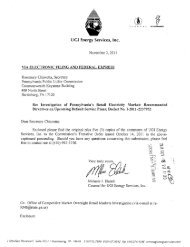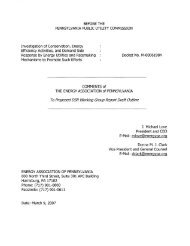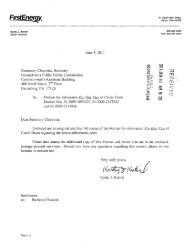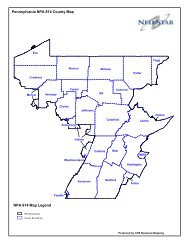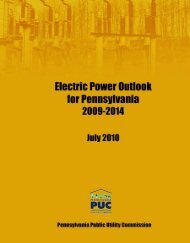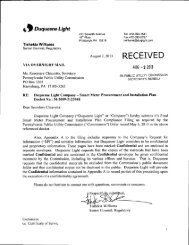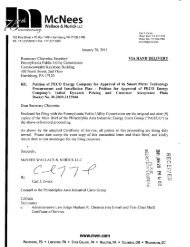METROPOLITAN EDISON COMPANY - Pennsylvania Public Utility ...
METROPOLITAN EDISON COMPANY - Pennsylvania Public Utility ...
METROPOLITAN EDISON COMPANY - Pennsylvania Public Utility ...
- No tags were found...
Create successful ePaper yourself
Turn your PDF publications into a flip-book with our unique Google optimized e-Paper software.
Staff’s Follow-up Recommendation – Perform a review of contractor staffinglevels and conduct an employee span of control analysis by department on anannual basis striving to limit the number of span of control ratios outside therange of 1:5 – 1:7.Prior Recommendation – Examine the level of overtime being paid as it relates toensuring adequate staffing levels.Prior Situation – BWG found that the FE-PA Companies’ overtime had increased from2000 levels and was relatively high compared to other utilities. Overtime as apercentage of straight time hours for the FE-PA Companies had fluctuated during theperiod 2000-2005, increasing by almost 50% between 2001 and 2002, decreasing byabout a third in 2004 and increasing again in 2005 by about 40%. Overtime at the FE-PA Companies had been over 15% in two of the last four years reviewed during theaudit.BWG estimated that the FE-PA Companies should be able to achieveapproximately $3.7 million in annual savings. This was based on the followingassumptions:• An average pay rate of $30 per hour and that the FE-PA Companies pay timeand a half for overtime hours; BWG calculated that the 518,782 hours ofovertime in 2005 cost the Company approximately $23.3 million- (518,782 hours x $30 per hour x 1.5 = $23,345,190)• BWG calculated that reducing overtime to 10% would save FE-PACompanies approximately $7.4 million.- 3,545,551 straight time hours x 10% = 354,555 overtime hours.- 354,555 hours x $30 per hour x 1.5 = $15,954,975.- $23,345,190 - $15,954,975 = $7,390,215.• Reducing overtime would in many cases require the hiring of additional staff.Thus, the actual savings would be offset by the cost of hiring additionalpersonnel. Consequently, BWG concluded that the FE-PA Companies wouldbe able to achieve approximately half of the savings, or approximately $3.7million.Follow-up Finding and Conclusion No. X-2 – An analysis of overtime hours for theFE-PA Companies line worker groups has not been performed.In 2007, FirstEnergy engaged an outside consultant to perform a Workload andManpower Planning Analysis. In 2008, a staffing model was implemented for use byFirstEnergy’s Forecasting and Planning group. The new staffing mode is similar to theone proposed by FirstEnergy’s outside consultant in that it was designed to helpmanagement gain a logical outlook on the past and future nature of the workload. Themodel looks at FirstEnergy’s historical workload, its current workload and theanticipated future workload. The model also takes into account the historical andcurrent manpower resources.- 65 -



